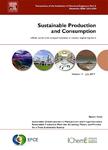版权所有:内蒙古大学图书馆 技术提供:维普资讯• 智图
内蒙古自治区呼和浩特市赛罕区大学西街235号 邮编: 010021

作者机构:Univ Guelph Sch Engn Guelph ON N1G 2W1 Canada Brunel Univ London Brunel Design Sch Kingston Lane Uxbridge UB8 3PH England McGill Univ Dept Mech Engn Montreal PQ H3A 0G4 Canada
出 版 物:《SUSTAINABLE PRODUCTION AND CONSUMPTION》 (Sustain. Prod. Consum.)
年 卷 期:2023年第41卷
页 面:253-274页
核心收录:
学科分类:0830[工学-环境科学与工程(可授工学、理学、农学学位)] 08[工学]
基 金:Natural Science and Engineering Research Council of Canada (NSERC) [RGPIN-2022-03448]
主 题:Additive manufacturing Life cycle assessment Design for additive manufacturing Design and process parameters Product-process co-design Machine learning Data-driven predictive model
摘 要:Additive manufacturing (AM), a disruptive technology of building parts layer-by-layer directly from 3D models, has been considered a tempting cleaner production process compared to other conventional production routes. This is because AM has demonstrated impressive green characteristics which contributed to significantly reduced material and energy consumptions, a shorter supply chain, and diversion of the waste stream by reparation, etc. The majority of the current quantitative studies on the environmental assessment of AM are based on utilizing the knowledge-intensive Life Cycle Assessment (LCA) methodology. Further, current studies on assessing the environmental performance of AM are based on a limited selection of design- or process-related parameters. These knowledge barriers may cause delays and challenges in the selection of the optimal design and process parameters for additively manufactured parts. Such challenges are particularly prevalent during the product design and planning stages due to the iterative design-evaluation process. Therefore, there is a need for an automated LCA tool to support AM toward elevated sustainability. As such, this paper provides three main contributions to the research community. Firstly, this is the first study to identify a comprehensive set of influential AM design and process parameters that pose an impact on the environmental performance of AM. Secondly, this review also summarizes the impacts of each of these parameters on the environmental sustainability of AM. Lastly, to the best of the authors knowledge, no work in the literature has been reported on automating LCA for AM. Thus, this paper promotes research toward a more environmentally benign and innovative AM technology by proposing a new framework to automate the environmental assessment of the process. The proposed framework is anticipated to take advantage of the fruitful integration between Machine Learning (ML) and the product process co-design concept to mitig